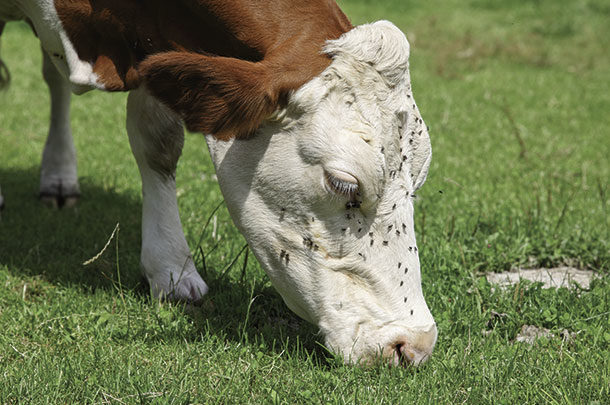We have billion-dollar problems in the beef industry. Here are a few of the commonly reported billion-dollar hits we take annually: fescue toxicosis, bovine respiratory disease (BRD) and, surprisingly, flies.
Our goal is to minimize these negative economic impacts and manage for profit.
A visit to the recent trade show at the National Cattleman’s Beef Association (NCBA) Convention in San Antonio confirmed that there’s not much in the way of new products for fly control.
Casey White, director of product development for Central Life Sciences, says, “We’re seeing less product development as all companies are limited in regard to active ingredients approved for use on food animals.”
There’s no new miracle cure for flies. The “new” products are based on unique delivery methods for already approved active ingredients. New insecticide eartags, fly baits and insecticide screens for use around livestock facilities are now on the market, according to Justin Talley, professor and livestock entomologist at Oklahoma State University.
The trick is utilizing the products available in a way suited for specific operations. That’s where a comprehensive integrated pest management (IPM) program becomes essential to achieving effective fly control. White says, “A good program should be built around the use of a feed-through fly control solution and include cultural control efforts such as sanitation, manure management and facility maintenance.”
The treatment threshold for adult flies is 200 per head, and a combination of delivery methods is the most successful strategy. Producers have to make decisions as to what program best suits their operation. Talley says, “There are many products that work well for three weeks but, unless you want to gather your animals up multiple times throughout the fly season, these types of products become too laborious.”
Resistance also contributes to poor fly control. Rotating between chemical classes can be challenging because the products do not state which chemical class they belong to on their labels. Furthermore, Talley says, 85% to 90% of available products contain the active ingredient pyrethroid and therefore are in the same class of insecticides. An integrated fly management strategy should take the fly’s biology into consideration.
In the traditional pasture setting, horn flies and face flies are the most significant fly pests; they lay their eggs in fresh manure. As soon as the manure hits the ground, horn flies leave the back of cows to lay their eggs. The most important pest in pastured cattle is the horn fly. Face flies are not blood-feeding pests, but contribute to pinkeye.
A three-pronged approach
For fly control, a three-pronged approach works best in the traditional pasture scenario. “Hanging your hat on one thing and expecting absolute fly control probably won’t be very successful,” says Larry Hawkins, DVM, Bayer veterinary scientific liaison. “Insecticide eartags, feed-throughs such as insect growth regulators (IGRs) or oral larvicides, in addition to oilers on the mineral feeder, create a well-rounded program.”
Eartags are labeled to be effective for 150 days; however, effective fly control is commonly closer to 100 to 120 days. Timing is important for insecticide eartags, ideally around late May or early June, a busy time on most operations. Many producers may be tempted to put them in earlier, during weaning.
Hawkins says, “If they choose to do that, they’ll have to supplement the eartag to control year-end flies. The best fly control comes from the use of multiple products throughout the season.” IGRs, larvacides and oilers are other methods of control that can provide extended relief.
Some operations have standards that prevent them from using traditional methods of fly control. Mark and Annette Thomas own TLC Grassfed Beef near Enid, Oklahoma, a ranch-certified grass-fed and animal welfare approved by A Greener World operation.
Annette Thomas says, “We rotationally graze our cows through the paddocks during the warm season, ensuring they don’t stay in one paddock too long. This is good for the grass and also ensures flies are in check because they aren’t continuously in paddocks with their fresh manure where eggs are laid.”
The Thomases also believe in promoting a healthy dung beetle population.
“Dung beetles are important for the breakdown of manure, thereby reducing the breeding grounds for flies.” They stopped using most parasite control, except insecticide eartags on spring calves in May to repel flies from them during nursing. They work with their veterinarian to select products that have less impact on dung beetles.
Anecdotally, the Thomases have observed mature cows and bulls rubbing on cedar trees, typically considered a nuisance plant, at various times of the year and believe the oils help with fly control.
According to Talley’s observations of fly seasons in Oklahoma, they’re longer and more intense each year. Producers are having to deal with other parasites like ticks and lice and are experiencing what he calls “parasite fatigue” from having to include a variety of control methods in their programs.
Confined operations
In concentrated animal feeding operations (CAFOs) such as feedlots, backgrounder operations and dairies, there’s a different fly problem.
The flies that lay their eggs in fresh manure like the horn fly or face fly have less fresh cow manure because confined animals mix the manure with dirt by hoof traffic, and there aren’t as many fresh pats for those species to lie in. However, the housefly and the stable fly are more predominant in confinement operations.
Stable flies have a painful bite that causes cattle to huddle together in an attempt to avoid the bites. This causes decreased performance and can reduce gains by 0.48 pounds with fly population numbers as low as four flies per leg.
Houseflies can carry up to 65 diseases, specifically Staphylococcus aureus, the bacteria responsible for most cases of mastitis. In the most severe infestations, they can cause cattle to go off feed.
The first step in stable fly control is sanitation, but chemical and biological control round out the integrated management plan. The biological component of stable fly control is the use of parasitic wasps. The wasps are small and lay eggs in the stable fly pupae.
Once they hatch, they feed on the fly larvae and, in about two weeks, the adult wasp emerges. These wasps can lay up to 350 eggs per day and are quite successful in reducing the number of adult stable flies.
Talley says, “Fly populations in CAFOs are controlled pretty well with parasitic wasps combined with targeted insecticide applications that utilize baits in problem areas.”
The success of the limited fly control technologies currently available is largely dependent on applying the appropriate strategy based on operation type.
There isn’t a single-shot approach that will control these expensive pests, but we can minimize their economic impact with an integrated approach.











